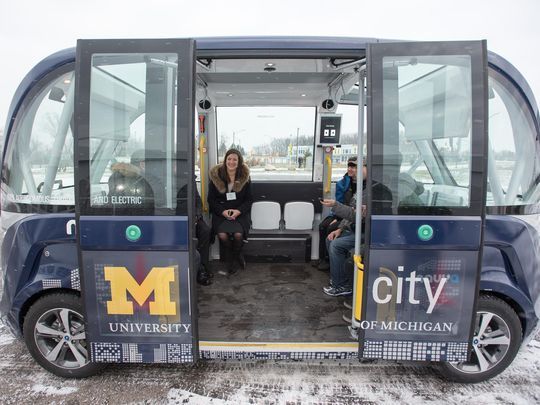
This fall, University of Michigan students can test out self-driving shuttles. Photo: University of Michigan
Self-driving car testing is now so common that people in California don’t even look up when one goes by. Tests have taken place in Arizona and Michigan, too, while New York State recently approved a year-long pilot program to test autonomous vehicles.
But thus far, members of the public have largely been unable to ride in the latest self-driving vehicles. That’s about to change.
This fall, the University of Michigan will become the first campus in the country to offer a self-driving shuttle service. There will be 15 Nayva Arma buses that will take riders between the North Campus Research Complex on the north side of Ann Arbor and the Lurie Engineering Center about a mile away. In all, the loop will be about two miles.
These students, faculty and staff members may be part of a historic shift in the way we get around. And, it could cause some societal disruption.
This past week, Robin Young, co-host of NPR’s Here & Now, talked to Huei Peng, the director of MCity, where the university is conducting its self-driving vehicle research. (I interviewed Peng at MCity for Here & Now last February.)
The self-driving shuttles grow out of the miniature town that Michigan has created so that car and technology companies can test their vehicles and autonomous vehicle features.
How they get around
In the interview with Young, Peng answered some of the questions that many people have had about self-driving vehicles. They operate in two ways. One is by fixed routes, in which the shuttles only travel from point A to point B and back. The other is by GPS, so that the shuttles can figure out alternative routes in case something gets in the way of their programmed route.
That’s vital in Ann Arbor, where construction is taking place all over town, and where accidents and other obstructions are common. To be sure, the shuttles will travel a construction-free route, but high winds and blizzards can always cause havoc.
The university is also concerned about something I’ve worried about. The shuttles just seem too tempting for student mischief. Peng talked about students wanting to cram into a shuttle and set a Guinness World Record. I’ve been concerned that some smart tech geek will figure out how to re-program a shuttle and take it to Chicago.
To prevent that, Michigan will have “safety conductors” on board each shuttle for the year-long test. They will not only watch the vehicles to make sure they are operating safely, but they also will keep watch over passengers to keep them in line, if necessary.
The safety conductors are also going to keep an eye on whether the shuttles actually follow their pre-programmed routes and/or switch to GPS when necessary. Michigan doesn’t know precisely yet whether the shuttles will automatically pull up at bus stops, how long the doors will stay open and whether they are giving people enough time to get on and off.
So, it’s being safer rather than sorry.
The impact on jobs
The shuttles also will test something else that has some employment experts concerned: are automated drivers better than human drivers?
According to the Bureau of Labor Statistics, 665,000 people worked as bus drivers in 2014, the latest year for which statistics were available, and it has been a growing field. BLS estimates bus driver job growth of about six percent a year.
It’s a profession that only requires a high school degree, rarely requires previous training, and which pays about $32,000 a year. It has seemed like every part of the country needs more bus drivers, and they’ve especially been in demand by school systems and the companies that provide drivers to schools.
So: what happens if self-driving shuttles become the norm across the United States? You could argue that they are better for passengers, because they eliminate the element of human error.
But, by introducing self-driving shuttles, we also might be taking away jobs. Labor leaders are already raising questions about the speed at which self-driving regulations are being approved
This isn’t just a conundrum facing bus drivers. It also faces truck drivers, taxi drivers and virtually anyone who makes their living behind the wheel. Sooner than we think, we could live in a world where mass transit vehicles no longer have drivers.
So, keep an eye on all the self-driving tests around the country. Just like smartphones, they could change more than what they are intended to change.
